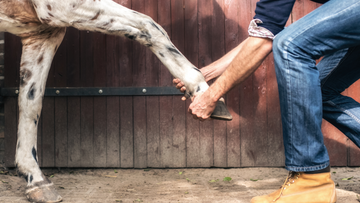Equine stretches provide numerous benefits to horses, including improving their flexibility, preventing injuries, and enhancing their overall performance. Just like humans, stretching plays a key role in maintaining a horse's physical well-being.
Horses, like any athlete, need a proper warm-up and cool-down regimen, which often includes a series of stretches. Integrating these stretches into a horse's daily routine can help maintain their suppleness, improve blood circulation, and reduce muscle tension. Moreover, stretching can also contribute to pre-empting potential injuries and promoting quicker recovery from physical exertion.
The full line of Benefab Equine Products offers performance benefits, injury prevention, and healing properties using far-infrared fabrics, medical-grade magnets, and the power of electromagnetism.
Try them for yourself today with a 30-Day Money Back Guarantee!
To ensure that equine stretches are safe and effective, it is essential to approach them with knowledge and care. Being gentle, patient, and attentive to the horse's reactions while performing these exercises will go a long way in fostering trust and cooperation.
Safe Ground Stretches to Begin With
When starting with equine stretches, it's critical to ensure the safety of both the horse and the handler. One simple and effective way of introducing ground stretches for horses is by using the carrot stretch. This popular exercise is designed to encourage the horse to stretch its topline, pelvis, and lumbar region while also providing a tasty incentive.
How To Perform Carrot Stretches
Stand next to the horse's wither or shoulder and present a carrot to encourage the horse to bend its neck laterally towards its elbow extensor group. Be sure not to force any movement, as this could cause discomfort or injury. Allow the horse to gently reach for the carrot, extending its neck as much as is comfortable. As the horse becomes accustomed to the stretch, it will develop a wider range and flexibility in its movements.
How To Utilize The Backwards Walk
This movement assists in improving the cross-sectional area of the muscle and provides a gentle yet effective way to strengthen and stretch the horse's shoulders. Encourage the horse to walk backward slowly and carefully, ensuring it maintains balance and engages the appropriate muscles.
In addition to the carrot stretches and backward walk, incorporating lateral neck and lumbar stretches into the horse's routine can significantly benefit its overall flexibility. These side-to-side movements focus on the wither and lumbar vertebral sections and help relieve tension throughout the horse's spine. To initiate these stretches, use a carrot to entice the horse to bend its neck sideways while remaining stationary.
It's essential to keep the stretches gentle and brief during the initial stages of implementing ground stretches. Over time, the horse will develop increased flexibility and strength, allowing for more advanced stretching techniques. By incorporating these safe ground stretches in a daily routine, you can improve your horse's overall well-being and performance.
Helping Your Horse Achieve Symmetry and Balance
Achieving symmetry and balance is essential for a horse's overall health and performance. Utilizing equine stretches can help maintain your horse's flexibility, strength, and coordination, resulting in improved movement and overall wellbeing.
Walking Exercises (Straight Lines and Curves)
It is essential for riders to be mindful of their horse's natural movement tendencies and adjust the intensity of the walks accordingly. Progressive training over time will result in a more symmetric and balanced horse, improving their riding performance.
Lifting Exercises
Lightly lifting a horse's foreleg and hind leg in turn helps them strengthen their core muscles and enhances balance. This will lead to improvements in the way they carry their riders and handle their weight distribution during various riding activities.
Lateral Neck Stretches
To perform this exercise, the handler should gently guide the horse's head towards its side, encouraging the neck to flex laterally. This stretch can help promote symmetry in the neck muscles and alleviate tension in the cervical area.
Tail Pulls
Involves the handler standing behind the horse, grasping the base of its tail, and gently pulling upwards and backward. The horse should be encouraged to lift its back, engaging the muscles along the spine. This stretch can help strengthen the back muscles and improve overall posture in horses recovering from injury.
Stretching The Stifle Flexors
To effectively stretch the stifle flexors, the handler should gently lift the horse's hind limb and hold it in a flexed position for a few seconds. This exercise can improve the flexibility of the stifle joint and contribute to a horse's overall stability.
As with any new exercises or routine changes, it is important to take into account the specific needs of your own horse. If you are unsure about anything, always confirm your horse’s limitations with your vet or horse care professional.






















